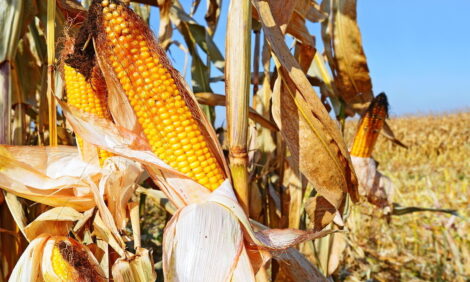



Start Cattle On Corn, Finish On Co-Products
The traditional practice of finishing cattle on corn may not be the only way to achieve high marbling, a desirable characteristic of quality beef.Researchers at the University of Illinois have discovered that high-quality beef and big per-head profits can be achieved by starting early-weaned cattle on corn and finishing them on a diet high in co-products.
"The goal is to get the highest quality beef product in the most profitable way," said University of Illinois animal scientist Dan Shike. "If you can initiate marbling at a young age with corn, calves are smaller and they eat much less, so feeding them corn for 100 days early saves on feed costs. This system will use considerably less corn and achieve the same effect."
For the study, heifers from the Dixon Springs Agricultural Center were weaned at an average age of 77 days and fed a high-corn ration for the next 146 days to initiate marbling. Then the cattle were divided into four groups: pasture-fed; high starch; intermediate starch; and low starch . The cattle remained on these treatments for 73 days. Then, all cattle were fed the intermediate-starch diet for the remainder of the finishing period.
Before being divided into the four treatment groups, the calves were ultrasounded to determine marbling. The ultrasounds revealed that marbling was initiated with the early corn diet. The cattle were ultrasounded again at the completion of the 73-day treatment period.
"The cattle on pasture had significantly lower marbling," Mr Shike said. "But there were no differences in the cattle fed varying levels of starch."
These results remained constant through harvest with pasture-fed cattle receiving lower marbling scores and fewer cattle grading low-choice. The cattle fed varying levels of starch had no difference in marbling scores. However, there were differences in profit per head.
"If you look at the overall profitability, we actually lost a little money on the high-starch group, the pastured cattle barely made any money, but the intermediate- and the low-starch groups showed a big swing. There's about a $45 difference between the high-starch and intermediate-starch treatment groups, and low starch was comparable to intermediate."
Why were the intermediate- and low-starch groups more profitable?
Cattle fed these diets achieved higher gains as efficiently or more efficiently as the high-starch group.
Another advantage to weaning calves earlier and starting them on feed means they can be harvested much earlier. "Our system is really an accelerated finishing system. It's not uncommon for our cattle to reach market end point and be harvested at 12 to 13 months of age. Whereas, in a more traditional weaning system, they might be 15, 16, or even 17 months of age. So, we're really taking four or five months off of that," Mr Shike said.
Mr Shike commented that when corn prices are high, this system is more cost effective because it utilizes lower priced co-products such as distillers dried grain, corn gluten feed, and soy hulls without sacrificing marbling quality.
"Additional research is needed," Mr Shike said. "But we believe feeding a high-grain ration to cattle at a young age and finishing them on co-products is the most profitable way to produce high-quality beef."


